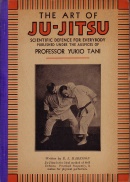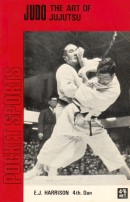|
|
The
Art of Ju-Jitsu by E. J. Harrison and Yukio Tani
|
| 

Do
a search on Abebooks!
|
 ukio
Tani (1881-1950) is the person widely considered
to be the first real ju jitsu pioneer in
Europe (England). There are a select few
that doubt if Tani indeed had the skills
as a teacher and fighter that many claim he
had. On the other hand there are a lot of
positive statements from wrestlers and others
who fought against him. You can read more
about it in the this
article (opens in a new browser window). ukio
Tani (1881-1950) is the person widely considered
to be the first real ju jitsu pioneer in
Europe (England). There are a select few
that doubt if Tani indeed had the skills
as a teacher and fighter that many claim he
had. On the other hand there are a lot of
positive statements from wrestlers and others
who fought against him. You can read more
about it in the this
article (opens in a new browser window).
|
|
Tani
was, along with S. K. Uyenishi (read
more about his book here) invited to
England
by the British engineer E. W. Barton-Wright . Barton-Wright is
said to have been taught Tenshin Shinyo ryu ju jitsu
by Yukio Tani. Other places (like in this
book: "Mastering Jujitsu", by Renzo
Gracie og John Danaher), it is claimed that Tani
had many of his mat-techniques from
Fusen ryu. This ju jitsu school is
the basis for the newaza you'll find in
Kodokan judo. Anyhow: Following a stint
with Barton-Wright as his agent, Tani worked
for William Bankier for a four to five year
long period.
|
|
Ernest
John Harrison (1873-1961) was a journalist and
translator who spoke many languages. He
was exposed to the art in Japan in 1897. Harrison
was rumored
to be something of a hot-head and a tough
guy who backed down to no-one. W. E. Steers
and E. J. Harrison was the first non-Japanese
to be graded to shodan (first dan) in Kodokan judo.
|
|
And
this is exactly what you will find in "The Art of
Ju-Jitsu",
Kodokan judo, that is. Various techniques
are shown with a drawing, supplemented with
lots of text. This book seems to be from the 1940's
or 50's. There is no indication of this
within the book.
|
|
The
lower, red and black book, "Judo, the
Art of Jujutsu", is identical to the
above mentioned one, something that is written
in the book:
"(...) Formerly published as The Art
of Ju-Jitsu". The only difference that
I am able to spot is that there are a few
actionshots form judo-fights in the newer
book. To me it is fair that judo is presented
to a larger extent - after all the
are no trace of ju jitsu here. Why they
still have kept the jujutsu name on the
cover of a judo book from 1960 beats
me. Maybe someone more knowledgeable can
shed some light on this?
|
|
There is even another
version of this book where Tani is not being
mentioned: "Easy-to-Learn
Jiu Jitsu". Click
here to
have a look at it! E. J. Harrison also wrote
the famous book: "The fighting Spirit
of Japan". You can read more about
this book here.
|
|
All
these books can be found on Abebooks from
time to time. And the prices will not scare
you either! I highly recommend them, and
that you do a search there. |
|
|
|
 ISBN nr.:
ISBN nr.:
|
-
-
|
|
 Author:
Author:
|
E. J.
Harrison
|
|
 Published:
Published:
|
Philadelphia
(Ju-Jitsu), Liverpool, G.B.,
1960 (Judo)
|
|
 By:
By:
|
David
McKay Company (Ju-Jitsu), W.
Foulsham & Co. Ltd. (Judo)
|
|
|
Back
to the page: books (click
here)
|


